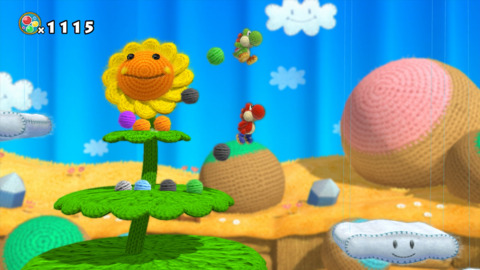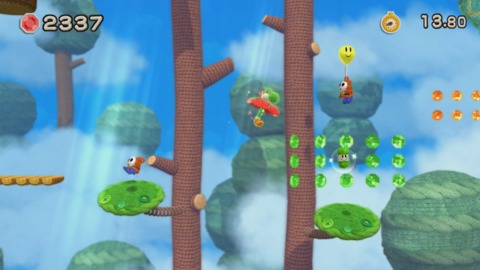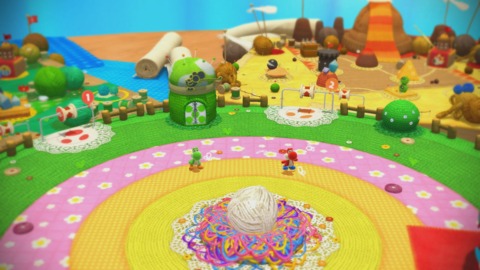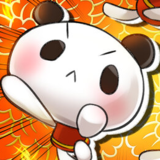It's hard not to love this game. It's also kinda hard not to hate it sometimes.
By cloudymusic 1 Comments
It should go without saying at this point that Yoshi's Woolly World is a beautiful game. Its visual style is consistent and extremely well-applied, lending the game's familiar objects and enemies an almost impossible level of charm and cuteness. The sound and music has been completely top-notch as well, standing on par with greats like Super Mario 3D World. This sort of polished-to-a-sheen presentation seems practically expected from most big-name Nintendo releases nowadays, but despite all of the attention that's been given to the game's presentation, I feel like some things could have been done a little bit better in terms of the actual game design.
I want to be clear up-front that I have generally loved my time playing this game. I will more than likely play it through to the end, which, being a very rare thing for me these days, should say something. I just think that it's much easier to enjoy when you're just "playing" it, solo, and not worrying too much about the collectibles.
The Good

I've already said that Yoshi's Woolly World has an irresistible charm. It's far beyond played-out to gush about it so I'll spare you, but the game really does put a smile on your face as you play it. Meeting new (or familiar) enemies and exploring new environments is always a treat, if only to see how the game's aesthetic has been applied to them.
The core Yoshi's Island gameplay still generally holds up. I've never been a mega-fan of Yoshi's Island the way some people are, but I enjoyed it at the time despite disliking a few elements, such as the vehicle segments. Throwing eggs, platforming with the flutter jump, and shooting watermelon seeds are all still fun. While I have some minor annoyances here and there that I'll get to in the next section, overall, this is a game that is just thoroughly fun to sit down and play through. If you liked Yoshi's Island, you owe it to yourself to at least give this game a try.
I'm not going to spend much more time talking about what's good about the game, because it should be obvious. Not to downplay its positive aspects, but you probably already know whether you're interested in the core premise. So, let's move on to...
The Bad
The Collectibles

This doesn't seem to be a particularly uncommon sentiment out there on the internet, but I think it really bears repeating. Unless you're a total fanatic, discard any impulse that you may have about wanting to 100% each level. Collecting all of the flowers and yarn balls is daunting enough, and going for heart and stamp collection in each level on top of that might actually drive me crazy.
Aside from the sheer number of collectibles is the matter of how you have to go about collecting them. If you're lucky, a collectible will be in a visible (perhaps easy-to-miss) but hard-to-reach area, leading to a fun challenge as you puzzle out how to reach it, especially if it involves tricky platforming that you wouldn't otherwise need to do. Those add a nice challenge, and are fun; I wish there were more of those. Too often, however, collectibles are hidden behind literally invisible "?" clouds that don't appear at all unless you happen to get close enough to them. Sometimes they're placed in spots that are obvious enough, but as soon as I stumbled into a few that were in an out-of-the-way area or floating high in the air in areas that I had no real reason to go to, I began to realize that hunting for all of these things was going to have to follow an utterly tedious "walk on every inch of ground, jump around on every platform, shoot every target" search routine. Even if there's seemingly nothing left to do on a screen and a more-exciting looking section beckons you up ahead, you'd better stop and check above, under, inside, and around every single inch of walk-able terrain, because if you don't, you're going to have to play the whole level again later to get the stuff you will undoubtedly have missed. (Similarly, if you want to get every stamp, you have to plan to get literally every gem in the level, because without using badges, you have no way of knowing which ones are special stamp-containing gems and which ones aren't. Luckily, stamps are much easier to ignore.)
At least in Super Mario 3D World's case, you were only missing out on a single challenge level at the end of the game if you weren't interested in topping every flagpole and finding every Miiverse stamp. In Yoshi's Woolly World, though, each of the game's six Worlds have an unlockable level that requires collecting all 40 Flowers in that World to access it, plus one more at the end if you've collected every flower in the game, making a total of 7 levels that you'll be missing out on -- which, in a game with 48 "normal" stages, is actually pretty significant -- if you don't diligently hunt for every last invisible flower.
The Co-Op Experience

The way co-op play is handled in Yoshi's Woolly World is...interesting. It seems to generally follow the philosophy of latter-day Mario games, where you can fully collide with one another and generally ruin each others' day -- intentionally or unintentionally -- but player death is relatively low-consequence and you can continue on as long as at least one player is alive at any given time to bring the other player back into the game. My problem with the game's co-op so far has been twofold: first, the game's level design regularly seems blatantly at odds with the co-op mechanics. Second, Mario-style co-op is even more frustrating than normal when you add egg-throwing and enemy-eating into the mix.
Let's focus on the first one for the moment: the game's levels seem creatively designed and fun to play when you're playing solo. And another player, though, and it starts to feel like the co-op mechanics and level design were done in complete isolation from one another, only coming together at the very end of the development process. From the very beginning, a lot of the game's levels have quite a bit of verticality to them, thanks to familiar Yoshi's Island elements like springboards, bouncy balls, and secrets that are frequently hidden just above or below the main playfield. The way that the game handles the co-op camera is that whenever one player moves off-screen, they're immediately "killed," abruptly lose all control, and are transformed into a floating egg that follows the surviving player around, who can then free them by simply jumping up and touching the egg. In the process, all of the eggified player's eggs (or yarn balls, I guess) are lost.
In the absence of a proper split-screen camera, this method sorta works, I guess. But the frequency at which this happens quickly becomes maddening as the levels are often designed to bounce you high in the air, causing one unfortunate player to suddenly die, sometimes seemingly out of nowhere. 19:26 in this video shows a comical example where a literally harmless bonus room with trampolines causes both players to die at different times due to the mechanics of the camera. It's not a game-breaker, but since control is yanked away from you whenever this happens, the frequency at which this occurs can quickly become aggravating.
One way to help combat the co-op camera issues is to stay close together at all times. This can even be helpful, allowing you to jump on each others' heads to each tall areas and generally do stuff that you wouldn't be able to by yourself. Unless you're strictly coordinating what your game plan is, though, more frustration abounds as you both become far more likely to accidentally eat one another, block your egg shots, or otherwise just get in the way and make basic tasks harder than they need to be. If you get frustrated when playing Mario games co-op, I think the odds are pretty good that you might find this experience even worse. It can be good casual fun if you just sit back and go with the flow, but if you're trying to put in even the slightest amount of effort towards playing well, you might end up frustrated. Maybe the flying you get in "Mellow Mode" could help alleviate some of these issues, but I haven't tried it.
Odds and Ends

While most of the game performs well and looks great, the world map has a noticeably poor framerate, feels unresponsive to move around in, and looks worse than the rest of the game. I'm not really sure what's up with that, but it makes a poor first impression. I'm also not really a fan of all of the Miis standing around in-universe, but that's something that Nintendo has been doing for years at this point, so I'm willing to say that it's my own problem.
I'm also a bit puzzled at the lack of any option to aim eggs via the analog stick. The old-style control method doesn't really bother me, but it seemed like an obvious thing to include.
In Conclusion
Overall, I like Yoshi's Woolly World. It's a lot of fun, it's charming, and it's largely an enjoyable experience. I just think it's much more fun if you play it solo and don't worry too much about finding all of the hidden collectibles. If you want to play all of the levels that the game has to offer, you may want to stop hunting after you've uncovered all of the flowers and leave the rest alone.

Log in to comment